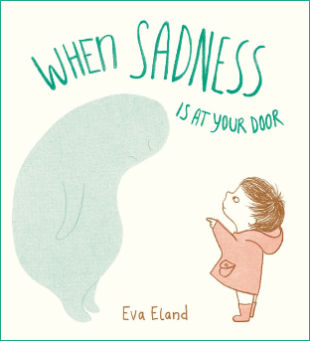Eva Eland's simple, evocative line drawings with their gentle shades of blue and rose accompany a story she tells with direct honesty and even a touch of humor. A young child on the title page reading a book nearly as big as the child looks up upon hearing a doorbell ring. We can see who's on the other side: An amorphous, rounded blue creature with a sad frown and downcast eyes.
Eland tells us that:
"Sometimes Sadness
arrives unexpectedly.
It follows you around . . .
and sits so
close to you
you can hardly
breathe."
This personified Sadness actually overlaps with the child crouched on a sofa, who looks not only sad but scared and intimidated. After acknowledging the urge to hide it — here the child tries in vain to close the broom-closet door on Sadness — the author shows how Sadness can completely envelop us, until "it feels like you've become Sadness yourself."
Eland then sets about teaching us how not to hide, but rather to listen to Sadness and what it needs. Her art takes on a heartful, reflective quality, with the child and Sadness sitting and drawing together, lost in their own thoughts, or even simply sitting together on the sofa — this time, side by side, with a wee space between, showing how we can give Sadness recognition, even friendship, without being taken over by it.
This story for young readers ages 3 - 7 occupies a hallowed space along with books like Charlotte Agell's Maybe Tomorrow? and Aaron Becker's A Stone for Sascha. These stories convey what Etty Hillesum, whose An Interrupted Life spoke of overwhelming sorrows, recommended with wisdom beyond her years: "Give your sorrow all the space and shelter in yourself that is its due, for if everyone bears grief honestly and courageously, the sorrow that now fills the world will abate."
